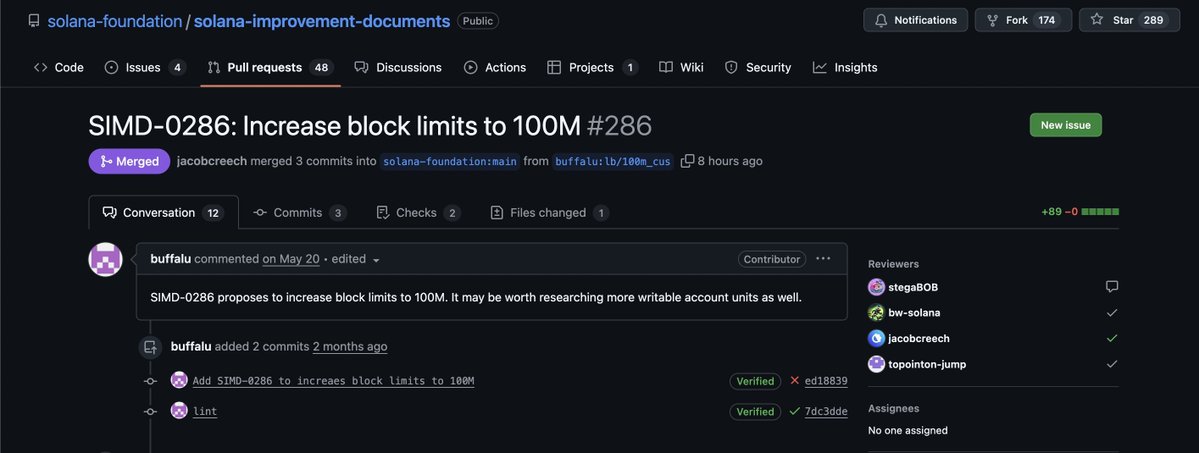This #SOL expansion upgrade is of great significance. The @solana SIMD-0286 proposal suggests raising the block limit from 60 million to 100 million CU, an increase of up to 66%. Such a major positive news has not been widely reported, so let me explain it briefly.
As an investor heavily invested in #SOL, we pay close attention to every event related to #SOL. The SIMD-0286 proposal sounds like a "technical upgrade," but essentially it is a significant performance release signal that could directly impact the upper limit of the entire #Solana ecosystem's value.
First, let's clarify a few key points:
💡 What is CU (Compute Units)?
CU is the unit that measures computing resources in the #Solana network; you can think of it as "how much can be done in a block."
For example, if a regular transaction uses about 1000 CU, and if the block limit is 60M (60 million CU), then a block can handle a maximum of 60,000 transactions.
Now, #Solana proposes to raise this value from 60M to 100M (100 million CU), meaning the processing capacity of a block has directly increased by 66%.
🚀 What changes will this bring? In my words, it can be summed up in four characters: earth-shattering.
✅ Greater throughput = More business implementation. Whether it's #AI on-chain inference, #DePIN real-time data uploads, or trading bots and blockchain games on #Solana, all of these require a lot of computing resources. An increase in CU means you can do more complex tasks in a block, truly releasing the value of "#Solana as a high-performance chain."
✅ Reduced congestion and gas volatility risk. When the block processing capacity is insufficient, the network can easily get congested, and gas fees can spike. With the increase in CU, #Solana will operate more "smoothly," like turning a 4-lane road into an 8-lane road, preventing traffic from bottlenecking.
✅ Smoother on-chain user experience. For end users, this means faster transaction success, less waiting, and more stable fees, making it as smooth as using Web2. For developers, they can confidently create more complex interaction logic.
🧠 How do I view this as an investor?
I see this proposal as a "second spring" technical signal for #Solana.
Think about it, #Solana is originally focused on high performance, and its TVL, user base, AI, and blockchain gaming ecosystem are rapidly rising in 2024. Now, with the computing ceiling set to increase by 66%, it can accommodate more high-frequency, highly interactive application scenarios. This is not like EVM chains that "slowly expand"; #Solana is directly "raising the ceiling."
📊 What chain reactions do I expect?
1️⃣ A new wave of DePIN / blockchain gaming / on-chain AI projects will prefer to deploy on #Solana.
Previously, they hesitated due to computing bottlenecks, but now there are no excuses; #Solana's state updates and response speed are sufficient to support AI inference or dynamic interactive dApps.
2️⃣ The popularity of MEV and trading bot projects will increase.
Higher CU allows for more complex trading calculations, especially in order matching and arbitrage path optimization.
3️⃣ The demand for #SOL will further increase.
More transactions + more complex interactions = more #SOL used for transaction fees;
At the same time, the rising ecosystem will stimulate more people to stake #SOL to compete for computing resources.
Overall, SIMD-0286 is essentially a "power boost declaration" released by #Solana: we are ready to welcome more complex and real on-chain economic activities.
🧐 From an investment perspective, I will focus on the following sectors:
1️⃣ #Solana native high-frequency trading protocols (such as @JupiterExchange, @RaydiumProtocol, @DriftProtocol);
2️⃣ On-chain gaming and AI module projects (like @rendernetwork, @drip_haus, @ionet);
3️⃣ Staking derivatives and LRT projects related to #Solana's performance release (such as @KaminoFinance, @jito_sol, @MarinadeFinance).

免责声明:本文章仅代表作者个人观点,不代表本平台的立场和观点。本文章仅供信息分享,不构成对任何人的任何投资建议。用户与作者之间的任何争议,与本平台无关。如网页中刊载的文章或图片涉及侵权,请提供相关的权利证明和身份证明发送邮件到support@aicoin.com,本平台相关工作人员将会进行核查。




